|
Further Speculations on the Secrets of
The Templars, The Inklings, Nikola Tesla and
Rennes-le-Chateau
Part Six
In the course of assembling the "Double Rainbow" pages for this site
that explore the connections between the Rennes-le-Chateau mystery
and the mysteries of the Martian Monuments, Iíve been carefully
searching the web both for the purpose of finding corroborative
information, and for the purposes of giving credit where credit is
due, for Iím certainly not the first to propose the connection,
although Iíve bothered to justify it on my own terms rather than
take someoneís word for it, Iíve run into Bruce Coronetís Cydonia
Reports, which I never should have lost touch with, where of course
he has been making the same connection for some time, and of course
his being way ahead of me, heís added many amazing things, including
an ancient replica of the face on Mars in New York state. The
connection probably isnít surprising to anyone whoís well versed in
the
earth grid and the
Sacred Geometry.
Iíve also run into the "I Wonder Productions" site, with many
incredible enhancements of photos of Mars by Liz Edwards, and many
amazing links, and Iíve been very taken with a close-up done by Liz
of a photo taken directly from the image at a NASA site, showing
what seems to be a city or other artificial structure near the
southern polar ice cap on Mars.
Liz also devotes a page to the possibility that an ancient Roman
map, recently discovered, corresponds to this mysterious city on
Mars, and she could very well be right.
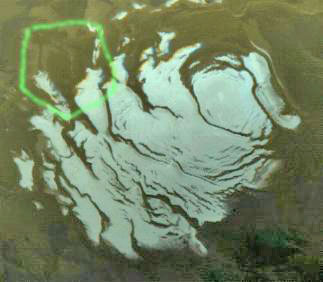
Above: a detail from the Martian polar image from the
NASA site,
with the apparent pentagonal geometry outlined in larger, similar
geometry. This is the source for the detail of Liz Edwardís skilled
enlargement, which can be found on a page of her site.
Even though the surfaces of at least one extraterrestrial planet in
the solar system are littered with five (and six) sided geometry,
there is much less chance of mistaking something like this. The
medieval-like courtyard and tower seem obvious.
Is it with knowledge of this place that C. S. Lewis wrote of a
medieval-like city on a long barren world in his Chonicles of Narnia,
in "The Magicianís Nephew"? The giant queen of Lewisí work conjures
up both the traditional speculation about the size of beings born or
living under different gravity than earthís own, and some
possibilities about the scale of this image. I am unable to tell you
yet how big this structure actually is, and it may look deceptively
small to the extreme.
Just to get a second opinion, I enlarged a cropping of the NASA
image and increased the contrast myself, and produced versions of
the same image that show how unmistakably regular and precise the
wall of this structure seem to be.

Something else that was observed in my own meager derivatives of the
NASA images is that the wall that you see running vertical on your
screen on the side of the structure seems as if it may be the long
part of an Egyptian crux ansata or ankh, formed by the wall
extending further to the left and topped with the ring behind it, at
upper left in this image. If so, it may lend both more confirmation
and perhaps more importantly, context, to this Martian polar city.
The whole area around it in fact may prove to be littered with
artificial sites; there are at least two remarkably square sites to
its left in the original NASA photo, and other odd pentagonal
geometry arranged very close to it and possibly even another face,
particularly to its upper right in the NASA scene.
The ability to identify the sharp and straight features of the wall
alone may quickly distinguish it from any of the naturally occurring
permanent and transient pentagonal geometry that has been seen on
Mars over the last century, as may a more certain identification of
the ankh.
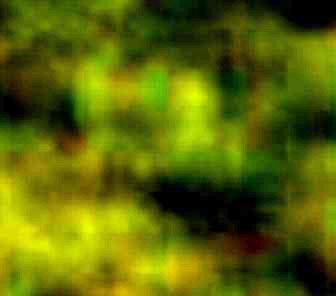 
In the best image I have so far managed to extract from the
NASA
original, you can see indeed that the tower of Liz Edwardís city is
there.
Itís worth pointing out that the earthly tower built by the Templars
that had such a starring role in a fateful and amazing television
program was also white, with a black conical roof.
There also seems to be, behind and to the left, a possible square
structure. Am I imagining things or is there a protruding tower at
the left side of this square structure which gives it overall an
astonishing resemblance to Sauniereís tower, at right?
We may be one decent enlargement away here from one of the most
amazing confirmations of a connection between Rennes-le-Chateau and
Mars that is possible.
The possibility that ice may have difficulty forming on this
pentagonal city site, as well as the apparent absence of any meteor
strikes, may imply that the formation is equipped with a mode of
shielding against such events, possibly by its geometry tapping the
planetary power of equivalent geometry.

Here is the best view of the first possible southern polar face I
can produce at the moment. Maybe itís nothing, and maybe eyes, nose,
mouth and chin are visible, and the suggestion of symmetry is
further reinforced by another set of paired features above the head,
as if this possible Martian faceís human animal fusion may take the
form of an animal head appearing above the human face, rather than
being superimposed upon or fused with the human features, as is the
case with the Cydonia face.
The more I see of this, the more I think. I would have too easily
presumed that every image on Mars has been found by the Enterprise
Mission team, but the fact is that they are only so many people, and
it may take even more eyes much more time to pick out every
possibility from the NASA images. Thereís still a lot for the
average person to do with it all, even with the readily-available
images, and thereís a sizable assortment of independent
observations, some of them very good ones, on the web to bear
witness to that fact.
Thereís probably a lot of good reasons to be looking at the photos
from other planets of the solar system, of Venus and Mercury, for
the same kind of possible man-made artifacts.
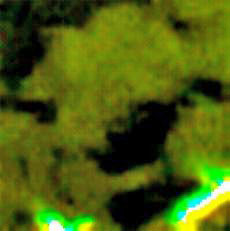
Here is the image of a possible second face in the south polar
region, very near to the previous one and to the right and slightly
up from it in the original photograph. Itís a curious one, where a
small face seems to be set off to the side of a very curiously
shaped area, but the face, if it is one, looks, not surprisingly,
very leonine, much as Richard Hoaglandís famous Face on Mars, "the
Martian Sphinx". The area is more complicated than the
D&M pyramid
geometry, but seems as if may contain it, and many artificial
features might be found in a clearer version of the same image.

The Utopia Planitia region
(above) of Mars may deserve a great
deal of interest. Using the "Armchair Astronaut" web feature the
other day, I chose this region first because this was the name used
on Star Trekís "Next Generation" for the place the Enterprise was
perfected. Not only have others found a very convincing additional
face in this region (below right), the image Iím using has numerous
strange, artificial-looking details.
One of them, apparently the largest, is this odd looking figure,
which is amongst the ancient rune figures found in magick.
 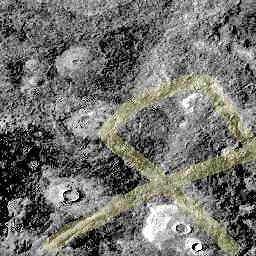
This rune is called "Othalaz" and other names. According to a modern
source, the meanings of this rune are, not ironically (but perfectly
appropriately):
"Homeland, property, inherited land, sacred
enclosure, inborn qualities, tangible possessions"
It is also a rune associated to the
moon and may here possess some
lunar significance, in addition to its other meanings, and is also
qualified to represent another form of the dolphin symbol which has
been found recurring repeatedly on the surface of Mars. The square
part of the rune has another square at the point, and what seems to
be a face, with a strange grail shape leading behind it from the
right. The Grailís cup may prove to be unusually triangular. It may
not be the only Grail on Mars. Some that seem to appear on both
Mars
and the earth are shown below.
A closer look at the face (right) shows it too may have a dual
nature, like the hybrid face of Cydonia, and perhaps these others,
for on the right side of the face appears what may be an entire face
perhaps much that most famous face of Cydonia.
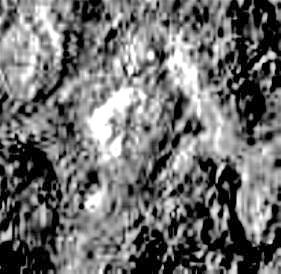 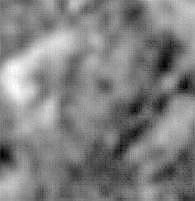
There are also a great deal of strange, unnaturally straight lines
and unnaturally straight geometry.
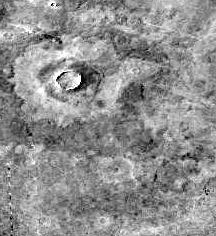 This
pentagon (below right) shows two points of a star, that may have been once an
entire one. This
pentagon (below right) shows two points of a star, that may have been once an
entire one.
I am obviously working to associate the Martian mysteries with the
ancient mystical traditions that might give us more clues to exactly
how those artifacts got there, and why, who knew they were there,
and how. It is the premise of this siteís Star Way pages of course
that not only do we have a possible explanation for that ancient
knowledge in the form of time cameras and magick mirrors, but
perhaps through physics forms of not only microscopy such as may
have provided the images of atoms found in these pages, but
telescopic views of the heavens.
Since Hildegard of Bingen may prove to have been one of the most
accomplished atomic seeresses, and the fruits of her visions as
physics concepts might be applied to transportation to Mars, we could
ask if thereís any evidence that she might also have been viewing
the surface of Mars or its artificial features, and the possibility
that maps showing ancient medieval-like castles is certainly a touch
of an invitation to revisit her visions, perhaps helping us to know
how deep and deliberate her intentions were, and just how much may
have been provided for us that we are perhaps not yet aware of.
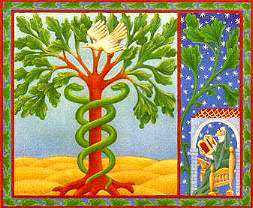
Hildegarde gazing at the heavens and Wormwood towering above her.
This herb not only may be part of her "migrainous" powers like the
migraine remedy Feverfew, it contains thujone or thujone-like
substances, and the aroma of either can also cause migraine or
headache in certain individuals. Wormwood is a Martian herb, under
the rulership of Mars in astrological terms, and in eclectic and
signature-based or homeopathic medicine. Besides the reputation of
its magnetic cousin, Mugwort, for liking to grow around blacksmithís
shops where scrap material might boost the level of iron in the
soil, that and other concerns that may make it appropriate for use
in colonizing Mars with vegetation.
Is its symbolic appearance here intended to communicate in part that
Hildegard was in fact star-gazing at Mars?
She will no doubt not be the only one who may have incorporated
Martian features into her artwork, but itís a reasonable
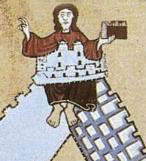  beginning
premise. beginning
premise.
Two of Hildegardís visions that have blatant anti-gravitational
themes, the "Zelus Dei" (left) and the "Sedens Lucidus"
(right) from
the Scivias. They are in fact fragments of one larger image
(below right), reproduced here as it appears in
Charles Singerís "Magic
into Science" in his extensive section on Hildegard and her visions.
The complete composite is Hildegardís vision of "The Heavenly City".
In spite of the Biblical connotations constantly assigned
Hildegardís far more mystical or Theosophical works, this peculiar
city, even in the odd way it is drawn "as a square but not a
square", has a not only recognizable but uncanny resemblance to the
geometry of the Martian polar city (shown inverted
below left),
both of them seeming to have, oddly, perhaps only one tower. In all
fairness, Hildegardís vision may be somewhat on the bland side for a
city of true heavenly glory, and its lack of literal realism is
quite obvious. Is it the Martian city? Does the red face of the "Zelus
Dei" symbolize the face of the Red Planet?
 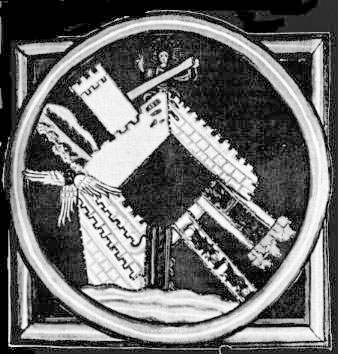
The geometry of Hildegardís "heavenly" city is also vaguely
suggestive of the Martian
D&M pyramidís (from DiPietro
and Molenaar) pentagonal geometry, a five
sided form of a normally four sided object. There is in addition at
the left side in this image, the hint of a square within the
pentagon exactly as in Hilegardeís artwork.
Back To Contents
|











 This
pentagon (below right) shows two points of a star, that may have been once an
entire one.
This
pentagon (below right) shows two points of a star, that may have been once an
entire one. 

 beginning
premise.
beginning
premise.
